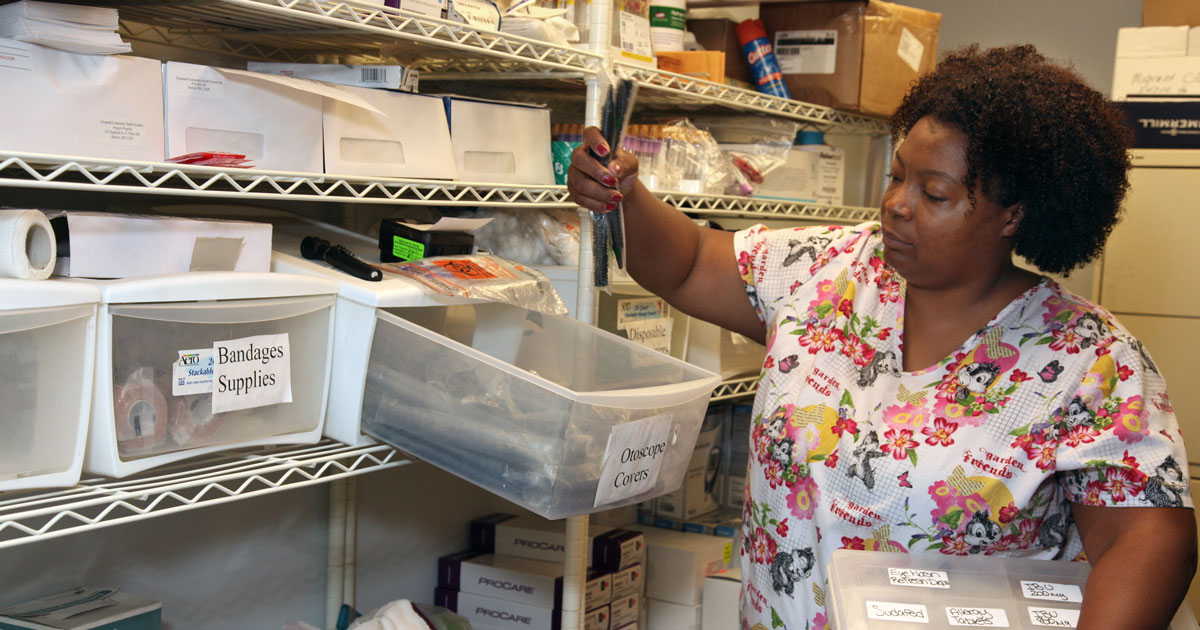


Events of recent years have highlighted the importance of planning and preparing for the continuity of health care services in the event of any type of emergency or disaster. Following a disaster, a thorough emergency response allows health centers to shifts gears to address the longer-term health consequences of disaster as well as the many health and safety risks from cleanup and demolition, both for those who were impacted by the disaster and for the mobile cleanup crews that arrive in the weeks and months after. Providing health care services to mobile underserved populations, like agricultural workers, poses a host of challenges to service providers under the best of circumstances, including isolated rural work and home locations, group housing, substandard housing, mobility, limited English proficiency, cultural factors, transportation, documentation status, and poverty. The significance of these factors is undoubtedly magnified under emergency circumstances.
Clinicians can serve an important role in helping patients to avoid disruption of their health care needs in an emergency by discussing safety and other prevention measures with them. In particular, those whose well-being is dependent on medications or medical equipment should be encouraged to have a personal emergency plan with important contact information and options for securing needed supplies and care.
Since emergencies are by their very nature unpredictable, the appropriate response for health centers will vary depending on the duration, scope, severity, and nature of the emergency.
Clinicians are trained to manage medical emergencies by establishing clearly defined roles and functions for the members of the health care team, using triage systems, establishing a safe and efficient care environment, reassuring patients through clear communication, and providing treatment swiftly and according to urgency and degree of need. These same principles and skills need to be utilized in emergency or disaster settings, and require planning and practice to function effectively in a time of need.

Protocols which focus on the ability to prioritize needs and to be able to function with limited human and material resources must be developed, and adequate time for training and drills must be allocated.
Critical issues for clinicians to consider in planning for the care of migrant populations in an emergency include:

Flooding in New Orleans, Louisiana after Hurricane Katrina
Days, weeks, and months after a major hurricane, earthquake, or other disaster, a new set of health concerns replaces the acute ones felt during the event itself. After Hurricane Katrina in 2005, thousands of workers arrived from around the US and Latin America to begin the long process of cleanup; displaced locals also joined the efforts. Many of these workers had no experience in post-disaster cleanup and the risks to their health and safety that they were taking. Injuries and illnesses relating to standing water, mold, and bacteria -- including skin abrasions and lesions, allergic reactions, and asthma attacks -- often increase after hurricanes, as do the injuries that make the construction injury one of the most dangerous in the country, like falls from unsafe structures or ladders or heavy machinery incidents.
Heat and dust are two more major risks. Warm temperatures, high humidity, and new worksites and workers mean that safety protocol to prevent heat illnesses may be less closely followed. After 9/11, thousands of cleanup workers were exposed to dust containing numerous toxic properties including silica and asbestos, leading to short-term health problems, long-term illness, and death.
Other health problems seen during cleanup include skin abrasions, allergic reactions, tetanus, and the health issues related to the increase in contact with insects and vermin. Just a week after Hurricane Harvey hit Houston in 2017, HOPE Clinic hosted a tetanus shot booster clinic and increased its ordering of the vaccination, and of basic first aid supplies like bandages and ointments, in preparation for such concerns.
Electrocution and fires from equipment or circuits in contact with water or had contact with water; carbon monoxide poisonings from enclosed generator or other equipment use; collapsing buildings; gas leaks; damage to chemical vessels, propane tanks, and other dangerous materials -- all can cause serious and life-threatening injury after a disaster.
For immigrant workers, these risks are compounded. Fear over immigration status may cause workers to be reluctant to complain of unsafe conditions. Culturally and linguistically appropriate trainings may not exist during quickly assembled disaster cleanups -- if training exists at all. Personal Protective Equipment may or may not be available; in some instances, employers have required workers to bring their own, which can be troubling when hardware stores are out of stock for weeks on end.
The safety concerns don’t end when work ends. Transportation and housing are limited and at times unsafe. After Katrina, immigrant workers were targeted for robberies as they made their way home from work because immigrant demolition workers, many of whom don’t have bank accounts or access to banking, are often paid in cash.
Occupational Safety and Health Administration (OSHA)
National Institute of Environmental Health Sciences (NIEHS)
National Council for Occupational Safety and Health (NCOSH)
Centers for Disease Control and Prevention (CDC)
American Public Health Association (APHA)
U.S. Department of Labor (DOL)
Barry Commoner Center for Health and the Environment
Clinician Resources for Occupational Injuries and Illnesses
Community-Based Resources
For additional technical assistance in planning for the clinical aspects of emergency preparedness and MCN's programs, please contact Marysel Pagán-Santana, MCN Puerto Rico Program Manager, mpagan@migrantclinician.org [20].
Links:
[1] https://www.osha.gov/dts/weather/hurricane/index.html
[2] https://www.osha.gov/dts/weather/flood/index.html
[3] https://www.osha.gov/Publications/OSHA3698.pdf
[4] https://www.osha.gov/Publications/OSHAFS-3699_sp.pdf
[5] https://www.osha.gov/Publications/OSHA3898.pdf
[6] https://www.osha.gov/Publications/OSHA3899.pdf
[7] https://www.osha.gov/Publications/OSHA_FS-3713.pdf
[8] https://www.osha.gov/Publications/OSHA3901.pdf
[9] https://tools.niehs.nih.gov/wetp/public/hasl_get_blob.cfm?ID=9716
[10] https://tools.niehs.nih.gov/wetp/public/hasl_get_blob.cfm?ID=9715
[11] http://coshnetwork.org/how-you-can-help-safecleanup-hurricane-harvey
[12] https://www.cdc.gov/disasters/management.html
[13] https://www.cdc.gov/disasters/cleanup/facts.html
[14] http://getreadyforflu.org/foodwatersafety.htm
[15] https://blog.dol.gov/2017/09/06/cleaning-staying-safe
[16] http://commonercenter.org/toolkit.html
[17] http://www.migrantclinician.org/toolsource/resource/eoh-screening-questions-primary-care.html
[18] https://goo.gl/RoGgom
[19] https://old.migrantclinician.org/files/staff/pdf/Democratizing%20Resilience%20-%20Community%20Action%20Plan%20for%20Disaster%20Response%20from%20Immigrant%20Communities.pdf
[20] mailto:mpagan@migrantclinician.org